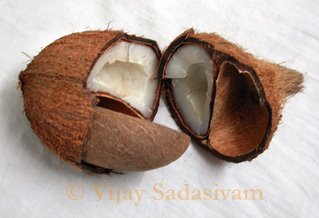Normal coconut has three eyes, or two eyes and one mouth,according to people perception and cultures. No more, no less! Except, of course, if they are coconut freaks!
The English name coconut, first mentioned in English print in 1555, comes from Spanish and Portugese word coco, which means "monkey face." It is said Spanish and Portugese explorers found a resemblance to a monkey's face in the three round indented markings or "eyes" found at the top of the coconut. A normal coconut have 3 "eyes", but not all the coconut with 3 "eyes" are ordinary ones as size, shape and disposition of the coconut "eyes" may vary a lot...
For illustrating this section, we can produce on request at least one large size HD poster (up to 180x100 cm in size). These posters should be adapted to each country, on a case-by-case basis, in order to prominently feature locally produced coconut products, and to promote the marketing of these local products. It is also possible to buy or rent items from the
personal collection of Dr R. Bourdeix.
©R. Bourdeix, 2021, section CCSF.
Coconuts with two or three kernels inside are indeed very rare! There are natural botanical rarities, which do not seem to originate from special coconut palms, but rather very rarely by chance. There is about half a dozen of coconuts with two kernels listed in the world, and as far as we know, only one with three kernels!

A coconut with two kernel inside was dicovered in India by the family of Dr Vijay Sadasivam, a a radiologist practicing in Salem, a small city in the southern Indian state of Tamil Nadu, during the year 2006. The precise coconut variety remains unknown. Dr Vijay had the courtesy to send us these photos and to authorize us to publish them on this website. Then we made search and we found that the oldest is in the collection of the British museum. It is represented at the top left of the pictures.





